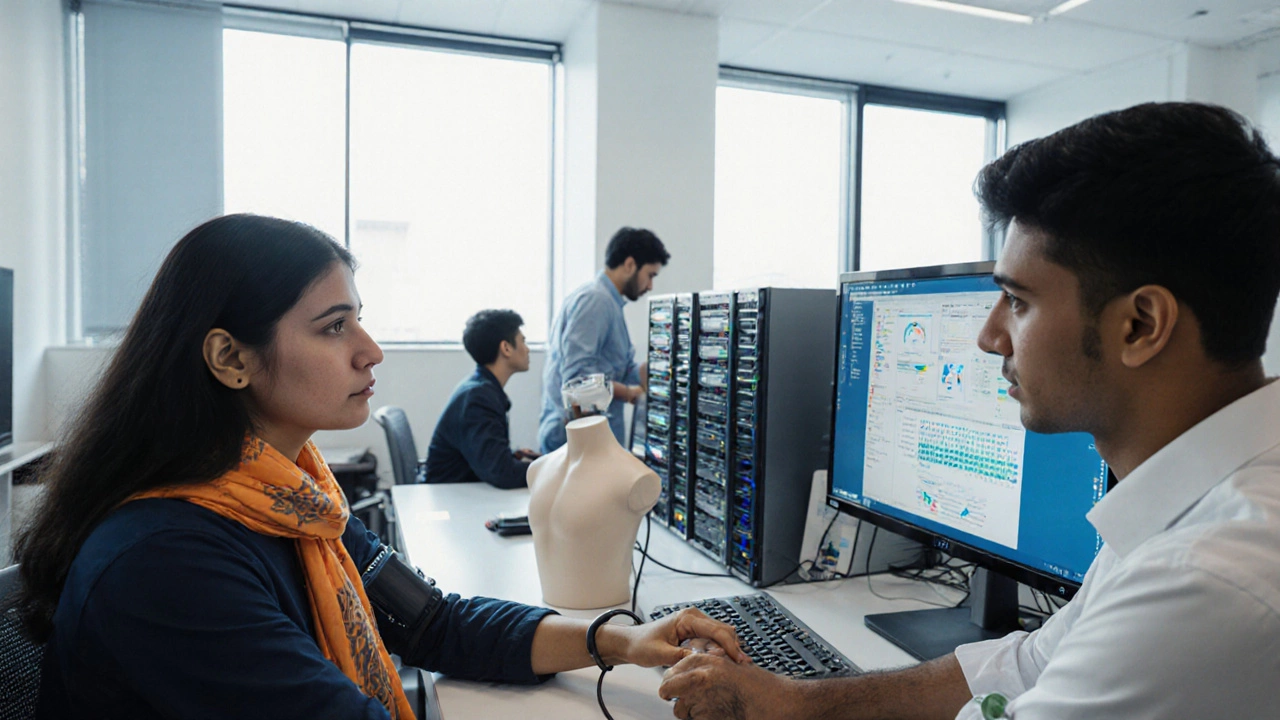Course Demand Comparison Tool
Compare the Top 5 In-Demand Courses
Select courses to compare their key metrics including average salaries, job growth, degree length, and international student support.
Course Comparison Results
| Metric | Data Science | Cybersecurity | Nursing | Software Development | Business Administration |
|---|---|---|---|---|---|
| Average Starting Salary | $115,000 | $103,000 | $78,000 | $90,000 | $115,000 |
| Projected Job Growth (2025-2035) | 28% | 31% | 19% | 22% | 12% |
| Typical Degree Length | 1-2 years (MS) or 4 years (B.S.) | 1-2 years (MS) or 4 years (B.S.) | 2-4 years (BSN) or 12-18 months (accelerated) | 2-4 years (B.S.) or 6-12 months (bootcamp) | 1-2 years (full-time) or 2-3 years (part-time) |
| International Student Support | High - dedicated advisors, OPT eligibility | High - labs, industry certifications | Medium - limited seats, clinical placement required | High - many programs sponsor visas | High - extensive networking, career services |
Key Insights
Cybersecurity offers the highest projected job growth at 31% while Data Science and Business Administration offer the highest starting salaries at $115,000. Nursing provides a more accessible entry point with shorter degree options but lower salary potential.
Ever wondered which course can actually open doors in the United States? Whether you’re a student in India eyeing a study abroad move or a professional looking to upgrade your skill set, knowing the most demanded course USA will save you time, money, and guesswork.
Key Takeaways
- Data Science, Cybersecurity, Nursing, Software Development, and Business Administration dominate U.S. enrollment growth.
- Average starting salaries range from $55K (Nursing) to $120K (Artificial Intelligence roles).
- Jobs in these fields are projected to grow 15‑30% through 2035.
- Most programs accept international students, but admission requirements vary by discipline.
- Choosing the right course depends on your career goal, budget, and timeline.
Why Some Courses Soar in Demand
Understanding demand isn’t just about headlines; it’s about the forces shaping the labor market.
First, the STEM fields that focus on science, technology, engineering, and mathematics sector continues to command the highest wages and fastest‑growing job openings. Companies are pouring money into digital transformation, which fuels a hunger for talent that can turn data into decisions.
Second, the aging U.S. population is stretching the healthcare system thin. This demographic shift creates a steady pipeline of openings for nurses, allied health professionals, and health‑tech specialists.
Lastly, globalization means businesses of all sizes need leaders who understand finance, marketing, and operations on an international scale. That’s why Business Administration remains a top pick.
Top 5 In‑Demand Courses in 2025
1. Data Science & Analytics
Data Science blends statistics, programming, and domain knowledge to extract insights from massive datasets. The Bureau of Labor Statistics (BLS) projects a 28% growth for data scientists through 2035, and entry‑level salaries average $115K.
Typical program: Data Science a multidisciplinary graduate‑level curriculum covering Python, R, machine learning, and data visualization. Universities like MIT, Stanford, and Georgia Tech offer both on‑campus and online tracks.
2. Cybersecurity
Every breach makes headlines, and companies are scrambling for defenders. The BLS forecasts a 31% increase for information security analysts, with median salaries around $103K.
Program highlight: Cybersecurity covers network security, ethical hacking, risk management, and compliance frameworks such as NIST and ISO 27001. Certifications like CISSP and CompTIA Security+ often accompany degree programs.
3. Nursing (RN & BSN)
Healthcare’s backbone, nursing, offers both direct patient care and leadership pathways. Projected job growth sits at 19% and median pay sits near $78K for registered nurses.
Course focus: Nursing combines anatomy, pharmacology, clinical rotations, and licensure preparation for the NCLEX‑R. Many U.S. schools now provide accelerated BSN tracks for students with prior degrees.
4. Software Development (Full‑Stack)
From mobile apps to cloud platforms, software developers are the engine of the digital economy. Employment is expected to rise 22% by 2035, with entry salaries around $90K.
Curriculum example: Software Development teaches JavaScript, Python, DevOps, and cloud services like AWS or Azure, plus agile project management. Bootcamps and university degrees both qualify, but accredited programs often give better visa support for international students.
5. Business Administration (MBA & Specialized Masters)
An MBA still packs a punch for aspiring leaders. The BLS notes a 12% growth for management analysts, and an MBA can boost earnings by 30‑50%.
Typical pathway: Business Administration covers finance, marketing, operations, and strategic leadership, often with options to specialize in entrepreneurship, supply chain, or international business. Top U.S. programs (Harvard, Wharton, Kellogg) now offer hybrid formats, making them more accessible to overseas candidates.

Comparison of the Top 5 Courses
| Course | Average Starting Salary (USD) | Projected Job Growth (2025‑2035) | Typical Degree Length | International Student Support |
|---|---|---|---|---|
| Data Science | $115,000 | 28% | 1‑2 years (MS) or 4‑year B.S. | High - dedicated advisors, OPT eligibility |
| Cybersecurity | $103,000 | 31% | 1‑2 years (MS) or 4‑year B.S. | High - labs, industry certifications |
| Nursing (RN/BSN) | $78,000 | 19% | 2‑4 years (BSN) or accelerated 12‑18 months | Medium - limited seats, clinical placement required |
| Software Development | $90,000 | 22% | 2‑4 years (B.S.) or 6‑12 months (bootcamp) | High - many programs sponsor visas |
| Business Administration (MBA) | $115,000 (post‑MBA) | 12% | 1‑2 years (full‑time) or 2‑3 years (part‑time) | High - extensive networking, career services |
How to Choose the Right Course for You
Not every high‑salary path fits every personality. Ask yourself these three questions:
- Career Goal: Do you want to code, protect data, care for patients, or lead businesses? Your end‑state narrows the field.
- Time Horizon: Can you invest two years in a master’s program, or do you need a faster bootcamp route?
- Budget & Visa: U.S. tuition varies from $15K (public universities) to $70K (private schools). Check each school’s International Student Office for OPT/ CPT options.
If you’re unsure, start with a short online certificate (e.g., Google Data Analytics) to test the waters before committing to a full degree.
Step‑by‑Step: Enrolling from India
- Research accredited U.S. programs that accept Indian applicants. Use the College Board International Search or each university’s International Admissions page.
- Gather required documents: Bachelor’s transcript, English proficiency scores (TOEFL ≥ 80 or IELTS ≥ 6.5), standardized test scores (GRE/GMAT, if needed), and a statement of purpose.
- Prepare for the visa interview. Highlight ties to India (family, property) and a clear study plan.
- Apply for Optional Practical Training (OPT) after you complete the course. This 12‑month work permit lets you gain U.S. experience.
- Consider scholarships or assistantships. Many STEM programs waive tuition for qualified international students.
Pro tip: Start the process at least 8‑10 months before the semester you want to join. Deadlines for fall admission often fall in March - April.

Pitfalls to Avoid
- Ignoring accreditation: Only schools accredited by regional U.S. bodies (e.g., Middle States, WASC) qualify for student visas.
- Overlooking hidden costs: Health insurance, software licenses, and living expenses can add $15K‑$30K annually.
- Choosing a “trendy” course without passion: High demand doesn’t guarantee job satisfaction. Align coursework with genuine interest.
Future Outlook: What’s Next After Graduation?
Most of these fields have clear career ladders. For example, a Data Science graduate can move from Junior Analyst → Data Engineer → Lead Scientist → Chief Data Officer. Cybersecurity professionals often transition to Security Architect or CISO roles.
Networking matters. Join professional groups like IEEE, ISACA, or the American Nurses Association while you study. Attend virtual career fairs hosted by your school’s International Office - they’re a goldmine for OPT‑eligible positions.
Quick FAQ
Which U.S. course offers the fastest entry into the workforce?
Bootcamps in Software Development or Cybersecurity can land you a junior role in 3‑6 months, especially if you secure a work‑study placement. Traditional master’s programs take 1‑2 years but often provide OPT‑eligible employment.
Do Indian students need a GRE for U.S. data science master’s programs?
Many schools waive the GRE if you have a strong GPA and relevant work experience. Always check the specific program’s admission criteria.
Can I work part‑time while studying nursing in the U.S.?
Yes, but clinical hours are mandatory and often full‑time. Most international nursing students focus on coursework and clinicals, then transition to full‑time work after graduation via H‑1B or TN visas.
What is the average tuition for a top‑ranked U.S. MBA?
For 2025, tuition at schools like Harvard or Stanford ranges from $75,000 to $80,000 per year. Many universities offer merit‑based scholarships that can reduce the cost by up to 50% for high‑achieving international candidates.
How does OPT differ from CPT?
CPT (Curricular Practical Training) is allowed during your study program and must be integral to your curriculum. OPT (Optional Practical Training) is a post‑completion work permit lasting up to 12 months (or 36 months for STEM fields).
Armed with this data, you can pinpoint the course that aligns with your ambitions, budget, and timeline. The U.S. job market rewards skill, not just a diploma, so choose a program that builds hands‑on expertise and opens pathways for practical experience.




